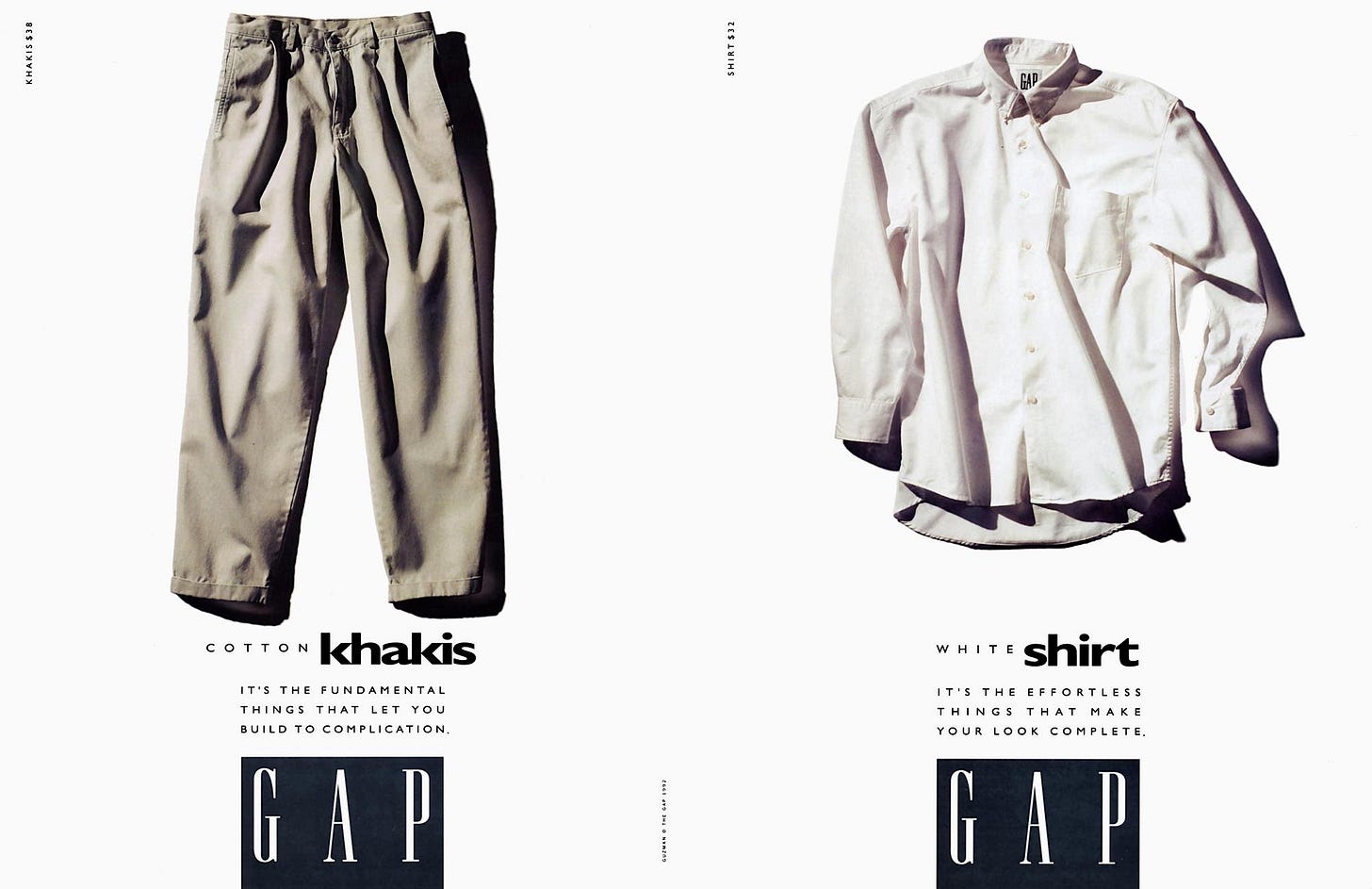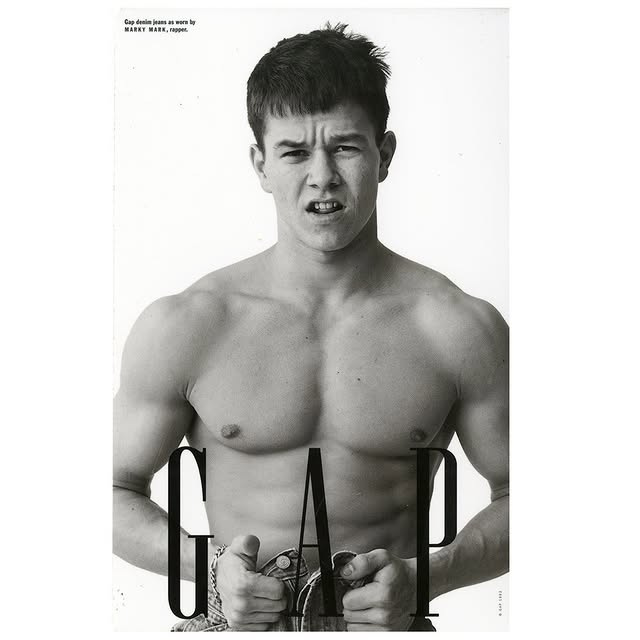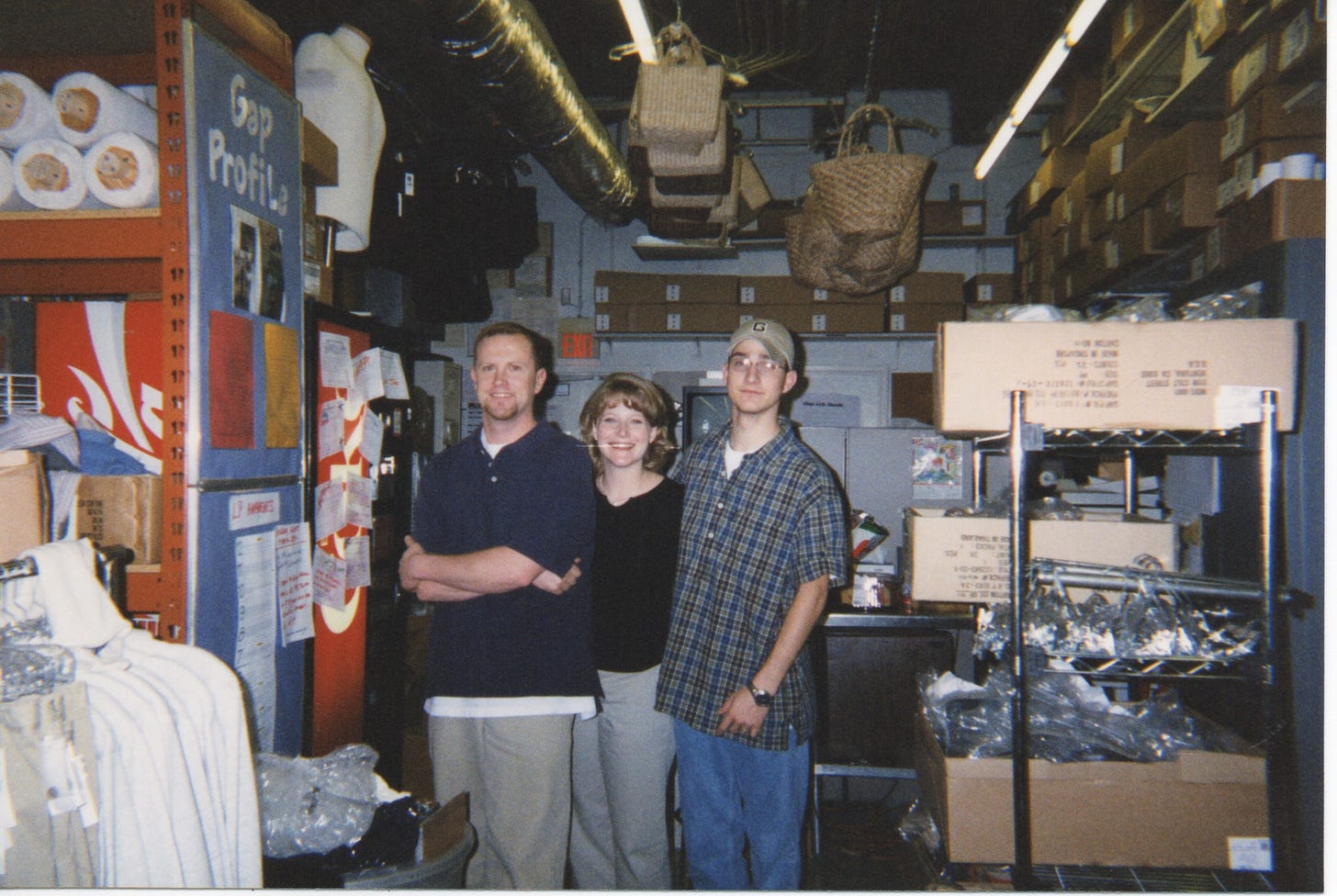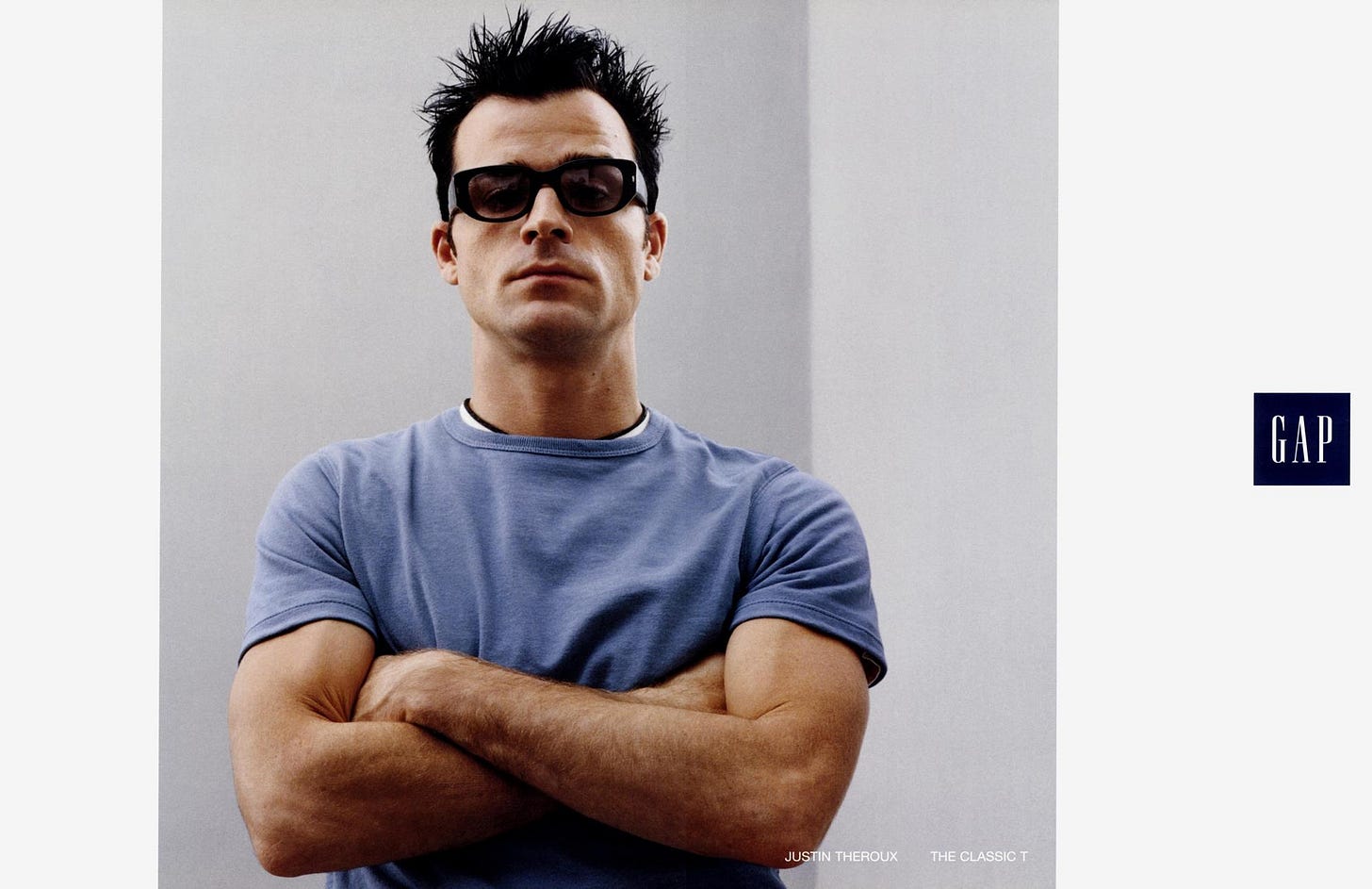The Enduring, Nostalgia-Inducing Charms of a Gap In-Store Playlist
A conversation with Michael Bise of @GapPlaylists.
Michael Bise was 27 years old when he answered an ad in the local paper for a job as a sales associate at Gap. Actually he applied for two jobs, one at a shopping center across the street from his apartment in Dallas, Texas, and another, further afield at Highland Park Village. In a twist of fate, he was offered positions at both stores, but opted for the the latter, despite it being a 20 minute drive away, mostly because it was in a wealthier neighborhood. “I don’t know what attracted me to Gap,” Bise, now 60, told me recently, admitting he didn’t even own any clothes from the store when he was hired. “But it was the only place I applied to.”
His first shift was a Saturday—October 17th, 1992—and he remembers it clearly: the crackle of a busy store on a weekend just on the cusp of holiday season. He was dead-tired at the end of that first day, “but there was something about it,” he recalls. “Something just clicked.” He’d end up working at the retailer for the better part of the next 14 years.
One thing he didn’t expect was the music. Bise is something of a melophile—growing up he loved disco, early-’80s New Wave, and ethereal divas like Stevie Nicks and Kate Bush. In the early 1990s, he was getting into what he called “gay bar music,” i.e. dance and house. He’d DJ house parties and make mix tapes, not just a playlist, mind you, but mash-ups where he’d layer one song over another. “They were flawless,” he boasted, noting he still knows the BPMs of certain favorite tunes.
So Bise was surprised to discover his new workplace had an unexpectedly of-the-moment monthly playlist, which, at that time, consisted of four one-hour tracks, so during an eight-hour shift you’d hear the entire thing twice through. It was a cross-sample of aural mood of the country at a particular moment: some alternative, a few lingering ‘80s bops, light R&B (no grunge, though). It was the sound of Gen X, boiled down to its eclectic essence.
“The way it was sequenced was done so well,” Bise recalled thinking. “It was The Cure running into Sabrina Johnston running into Erasure running into Simply Red or Annie Lennox. Soul II Soul, B-52s, Animal Logic, Sinead O’Connor.” Even his beloved Kate Bush was there, sampled in the Utah Saints’ song “Something Good”. There was a thread of house music running through it all, which captivated him. He was so smitten with the song “Love Breakdown” by Rozalla, featured on that October playlist, that when he got home after his first shift, he returned to the mall to buy her album.
Today Bise runs @GapPlaylists, a blog, Spotify page and Instagram account that seeks to exhaustively recreate Gap’s monthly playlists from roughly that 1990s period through the mid-2000s. It has since snowballed and now chronicles the highly-popular commercials and advertisements of that era which can be read as a snapshot of a bygone era (Mark Wahlberg photographed by Herb Ritts, anyone?). It certainly helps that that period was particularly fecund in a creative sense, no doubt due to its overlap with retail wizard Millard “Mickey” Drexler, who was ousted in 2002 after a meteoric 19-year tenure. In the mid-1990s to 2010s, the last gasp of a monoculture, the brand produced zeitgeist-defining campaigns. If Gap told the American public to wear baggy cargo pants, skinny striped scarves, or corduroy jackets, they happily complied.
Until 1998 the playlists arrived as tape cassettes delivered to the store with the songs and artists listed on a folded piece of paper tucked gently within; CDs came after, then digital. They kept the paper at the cash wrap because customers sometimes asked after certain songs. AEI Music made the playlists those days before Muzak took over in 1999, and then Muzak was acquired by Mood Media, an “in-store media specialist,” in 2011 for $345 million. Technically, employees were expected to send the tapes back each month, but Bise would keep the good ones, and no one from corporate ever mentioned them.
*If anyone was any information on the playlists from 1992-1994, please email michaelbise@msn.com*
I recently wrote a story about, among other things, the relationship between fashion and the literary world. But the truth is there’s much more of an overlap between music and fashion. In many ways, fashion is as much an aural medium as it is a visual one. Sure, clothes are made to be seen, to be experienced through the eye, but their end goal is not to be a frozen image, like a painting or photograph. Fashion is meant to move through and exist in time—like music.
It helps that fashion is obsessed with the business of “world-building” and music is the ultimate mood-setter. It’s transportive, much like smell. Music adds a layer of romance to something. A day ringing up customers, folding sweaters—or an hour in a store buying them—is somehow elevated from the prosaic to the poetic if it’s set to the right soundtrack. It’s why The Row releases its superb monthly soundtracks, I suspect, and why the music at some fashion shows are sometimes dissected like the Pentagon Papers. Fashion DJs—er, “sound designers”—can become celebrities in their own right.
Speaking with Bise, I understood why he dedicates so much time to this project. “I still dream about it,” he says, somewhat wistfully of those days. “It was challenging,” he added, “but it was exciting too. I’d go back and live that again, with all the horrible stuff too. It was the best time of my life.”
I also worked at Gap in the mid-00s, during the era of Sarah Jessica Parker’s 2004 holiday ads, and, while I don’t remember the exact songs, my memories of that time float within a sonic landscape of optimism. It was the Bush years, post-9/11, the Iraq War, and yet in my mind’s eye I mostly see the swirl of saturated colors, those grinning clean-faced models, and hear cheerful music with an expectant feel (some of this is, no doubt, just a byproduct of the blush of youth).
I worked there as a certain flavor of indie rock started hitting the mainstream, and the Gap playlists introduced me to artists like Death Cab for Cutie, Air, Postal Service, Scissor Sisters, and Tegan & Sarah, to name just a few. Like Bise, I look back on this time fondly, in no small part thanks to the music. For his part, Bise discovered artists like Hooverphonic, Morcheeba, Propellerheads through the playlists. “Some English bands that had these really off sounds,” he said. “But they were really cool.”
“Music and fashion—and all art forms—are so interconnected, it's how people express themselves and emulate the people they want to be,” says Paul Gould, the man who was in charge of curating these playlists by hand for many years, starting around 1999 (Gould, who worked at Muzak, notes these were very much a group effort). The amount of work that went into them in the pre-algorithm days is astonishing, but also sounds like a dream for any music fan. It centered on creating “a mix of familiar and relevant and new trends in music,” one that expressed a diversity of not just genres, but a mix of male and female voices, tempos, and an artist’s given relevance. Before the industry became about amassing electronic data points, it was a much more lo-fi, but charming, affair.
They would bring in, for example, a local record store employee to play them the newest, coolest stuff, and days often began just sitting around for an hour, listening to music. “One year, we had a ‘use it or lose it’ budget surplus for music buying,” Gould recalled. “[So] they sent me to Manhattan for a week to buy as much as I could. I still have a hard time believing it was real, getting paid to go record shopping.”
Of course, all this attention wasn’t just to curate good vibes. “There are all kinds of studies quantifying shopping habits and music, and it all boils down to making someone feel they are in a place that suits them at that time,” Gould noted. “One study said that the average customer spent 15 minutes in a store, so engaging them at least once in that time was crucial. The more time someone spends looking, the more likely they are to buy something.”
Gould recalled that holiday playlists were the both most rewarding and challenging, finding the right cheerful mix, nodding to classic carols without going overboard. This was complicated by the fact that it was before the days when every popular musician made a holiday album as a cash grab.
He was particularly proud of sourcing a Mos Def song, “May-December,” that took the classic Vince Guaraldi Charlie Brown Christmas keyboard lines and reworked them with a chill, low-key hip-hop beat. Other highlights from his era include songs from Belle & Sebastian, Feist, and Miguel Migs remixing Britney Spears. “It’s still a guilty pleasure,” he says of the latter.
Bise, meanwhile, continued to collect his favorite playlists over the years, but lost them in 2006, during a move from Dallas to return to central Texas to care for an ailing family member. It was, in a word, devastating. It would be a decade until he started his blog, with the hopes of recreating some of his beloved monthly compilations. He found someone on Facebook who had a trove, and a 2017 New Yorker article brought attention, which, in turn, brought people reaching out with additional playlists. The mothership itself caught wind of Bise’s project and dug through their own archives, which turned up some old CDs. In 2020, during pandemic lockdowns, they featured his blog as part of a campaign inspired to look back fondly on happier times.
Bise expanded from music and started posting old ads, which also received a warm reception. “They go together for me,” he said. Just a few weeks ago he posted commercials featuring the fall 2004 “How Do You Wear It” campaign starring Sarah Jessica Parker and Lenny Kravitz and the summer 2003 “New Groove, New Jeans” commercial starring Madonna and Missy Elliot, and went somewhat viral (he’s received 8 million views in the last three weeks, he said, and gained 26,000 new followers).
If you’re of a certain age (raises hand sheepishly) you can trace large swathes of your childhood with the music and images from the Gap campaigns: The “Everyone in Cords” campaign of 1999 set to “Mellow Yellow,” and the “Everyone in Vests” campaign of the same year set to "Dress You Up in My Love,” are core memories. Ditto the swing dancing khakis commercials of the 1998, and this 2003 broken-in jeans commercial set to “Tempted” may or may not have been one of my gay awakenings … the list goes on. They’re so popular that recent ads—Troye Sivan, Parker Posey, and their Linen Moves campaign—are an obvious callback .
Taken cynically, these playlists were just expert marketing, a way for a clothing brand to embed itself within the youth culture of the moment. To take broken-in khaki pants and denim jackets and make them synonymous with an ineffable idea of cool. Still, there’s a reason that, in recent weeks, friends have been sending me GapPlaylists posts of commercials that brought back a flood of memories or reminded them of a certain moment in their lives. Sure, it may just be great advertising dreamt up by savvy marketers to pull at our heartstrings, but some 20-30 years hence, they remain a potent portal to a different era, one that seems purer than our own.
“People love reconnecting with the music,” Bise told me. “And they call it their old friends — friends that you love that you lost, and now you found them again.”
*If anyone was any information on the playlists from 1992-1994, please email michaelbise@msn.com*
CONTINUE READING:










Fun read. I think it's also a testament to hiring people with good taste and giving them the freedom (and budget) to make creative decisions that aren't explicitly tied to profit.
I was hired at Gap as a holiday season temp in Cupertino in 1994, my senior of high school. Brought my best friend on board. We were then both hired full time and worked through summer 1995 before we went off to college in LA and Santa Barbara, respectively. We returned for a couple holiday and summer seasons in college. During summer 1995 our Gap store converted to Gap Warehouse, which was one of two test stores for what would become Old Navy. The first season of Old Navy was horrendous. I had a man try on a quilted shirt-jacket, and one of the sleeves was quilted shut when. At the register, I took a return when a customer brought in a long sleeve tee, and when I asked what was wrong with it, she took out the turtleneck part, which had come right off when she slipped the shirt over her head.
Anyway, I seem to remember my Gap years, which were definitely pre-1999, having the music playing on a 4-CD changer. Also, working at Gap made me hate Christmas music, except for Wham's Last Christmas and Mariah's All I Want for Christmas Is You, of course. I am gay afterall,